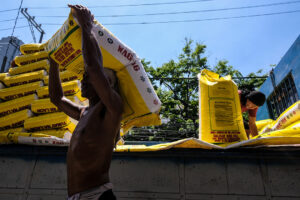




Monthly Economic Update: One for the road
 DOWNLOAD
DOWNLOAD

Inflation Update: Still low, still slow
 DOWNLOAD
DOWNLOAD

Philippines Trade Update: Exports momentum continues
 DOWNLOAD
DOWNLOAD


DA won’t recommend hike on rice tariffs yet

The Department of Agriculture said that it would not yet recommend raising tariffs on imported rice since retail prices have not gone down.
“Before 400,000 metric tons (MT) were shipped per month, since June, July, and August, almost 150,000 MT of rice have entered… So, it’s not enough stock for us to recommend the raising of tariffs,” Agriculture Secretary Francisco P. Tiu Laurel, Jr. told reporters on the sidelines of a poultry and livestock event on Wednesday.
Between the months of June and August, rice imports at a 15% tariff averaged about 150,000 MT per month, he said.
As of Aug. 22, Philippine rice imports amounted to 2.72 million MT, data from the Bureau of Plant Industry showed.
“The price of rice in the market has not yet decreased. Besides, the problem is, konti pa lang ang pumasok na bigas at 15% (few shipments came in at 15%),” Mr. Tiu Laurel said.
President Ferdinand R. Marcos, Jr. signed Executive Order No. (EO) 62, which reduced tariffs on imported rice to 15% from 35% until 2028, in an effort to lower the price of the staple.
EO 62, which took effect in July, mandated a review of the tariff policy every four months to reflect changes in global prices and supply. A review will be conducted by November.
Earlier, Mr. Tiu Laurel said the DA would propose to raise rice import tariffs once local prices fall to about P42-P45 per kilo.
Imported well-milled rice in Metro Manila markets was sold at P45-P55 per kilo, while local well-milled rice was sold at P48-P50 per kilo, according to DA’s price monitor as of Aug. 28
On the other hand, imported regular milled rice was sold at P46-P50 per kilo, while local rice was sold at P45-P50.
“I’ve always said that once you lower tariffs… it does not mean that the price will drop immediately because from January to June, a lot of rice was imported, almost 450,000 MT a month,” he added.
Mr. Tiu Laurel said that in the first half of the year, imports were in excess of the country’s 320,000 MT monthly requirement for rice.
“So, may excess talaga na nabili at nabayaran ng buwis nang mahal... Aabot ng mga mid-October or end of October para maubos ’yung old stocks (So, there is indeed an excess supply of rice that was purchased and taxed at higher prices. The old stocks could only be depleted by the middle or end of October),” he added.
The Agriculture chief said world rice prices remain elevated amid the ban on rice exports by the Indian government.
India last year banned on non-basmati white rice exports, citing the need to safeguard domestic supply.
“Plus, Indonesia and Malaysia are again buying rice for their buffer stocks, that is why international prices are not declining,” he added.
The Philippines remains the world’s top importer of rice, according to the US Department of Agriculture (USDA).
Asked to comment, Roehlano M. Briones, a senior research fellow at the Philippine Institute for Development Studies said traders are hesitant to import rice as various agricultural groups filed a petition asking the Supreme Court to nullify EO 62.
“There is no guarantee that the tariff valid on the date of making a purchase order will be the same tariff upon unloading at Customs,” he said in a Viber message.
Earlier, industry and farmer groups have questioned the validity of the EO 62, claiming a lack of public consultation and the threat it poses to local rice producers.
“In the market, they are saying that the price of rice will drop by P6 to P7 a kilo, but that would not happen because the traders have already imported the rice at a higher tariff,” Teodoro C. Mendoza, an agronomist and a retired professor at the University of the Philippines Los Baños, said in a phone call.
Foundation for Economic Freedom (FEF) President Calixto V. Chikiamco said the government should permanently lower rice import tariffs to 15% or adopt a variable tariff rate.
“(There should be) lower tariffs during lean season and higher tariffs during harvest season,” Mr. Chikiamco said in a Viber message. – Adrian H. Halili, Reporter
This article originally appeared on bworldonline.com





 By BusinessWorld
By BusinessWorld